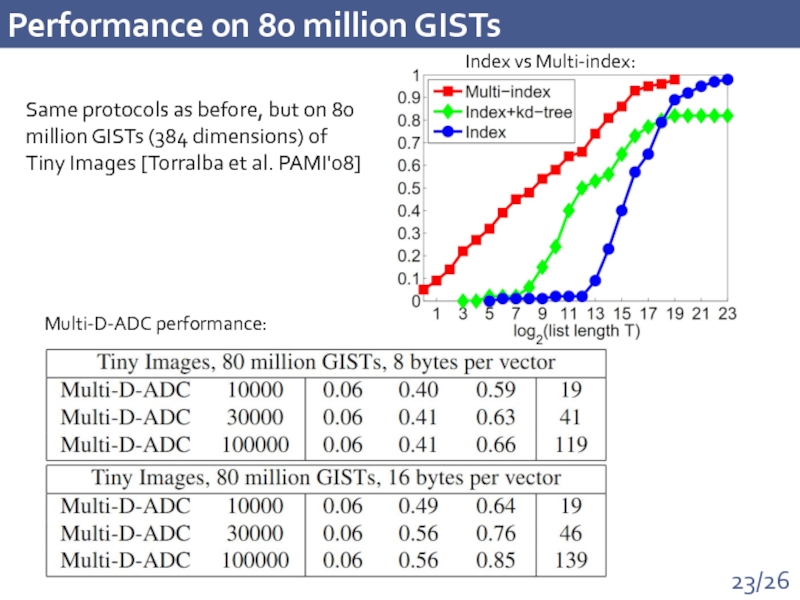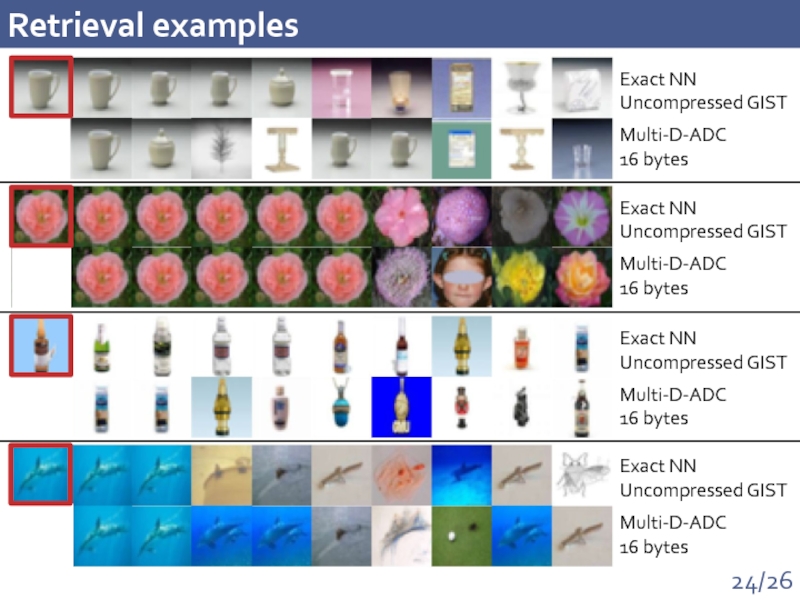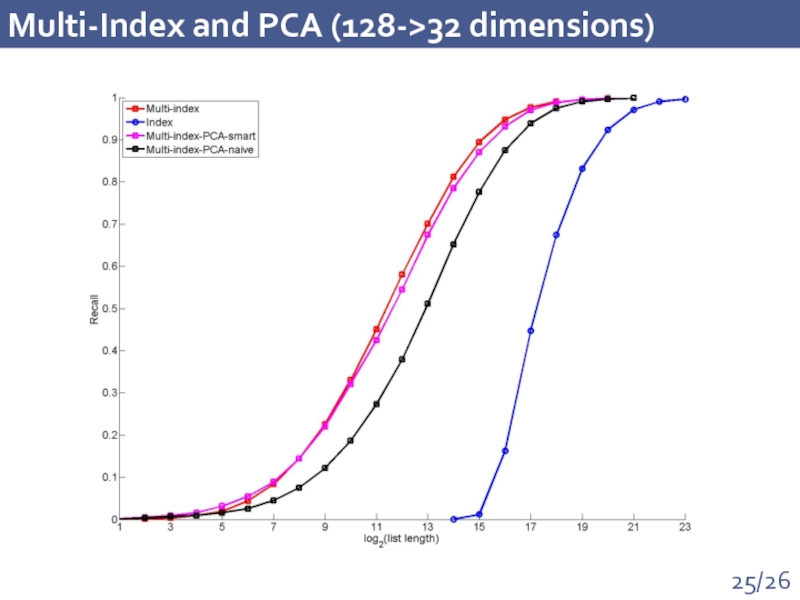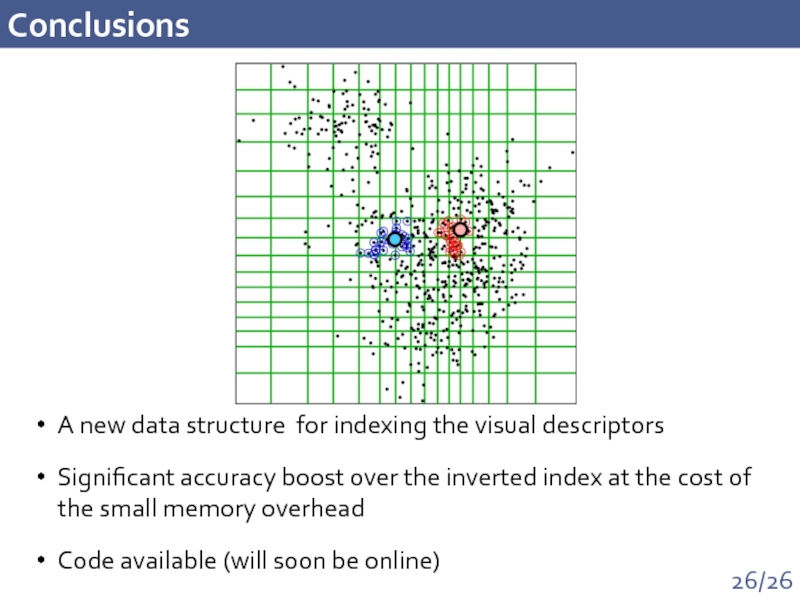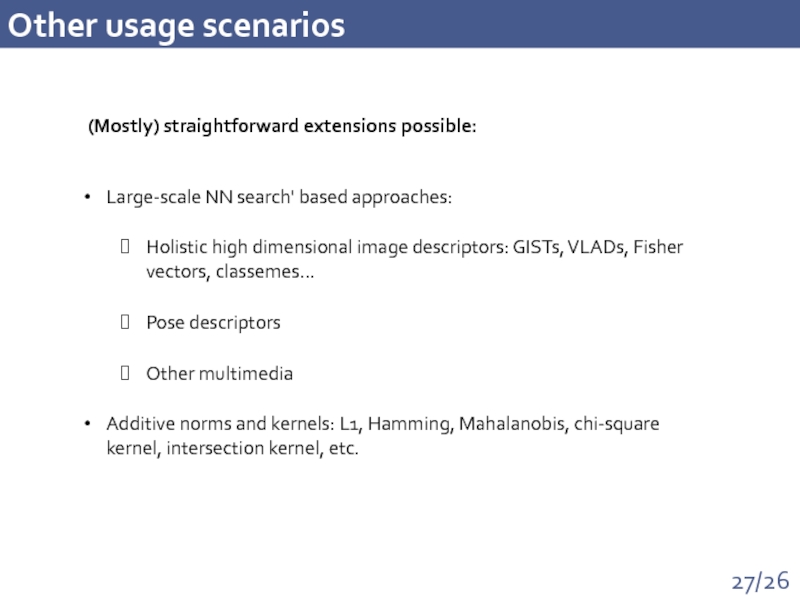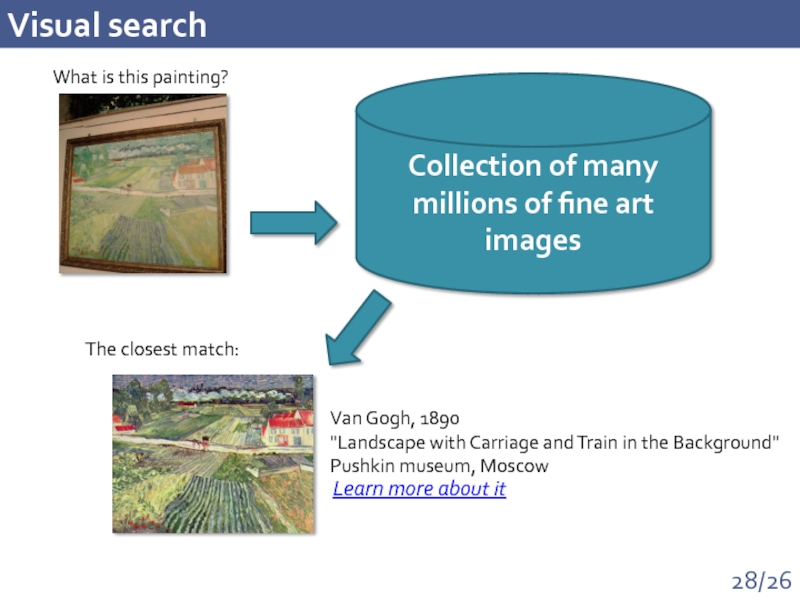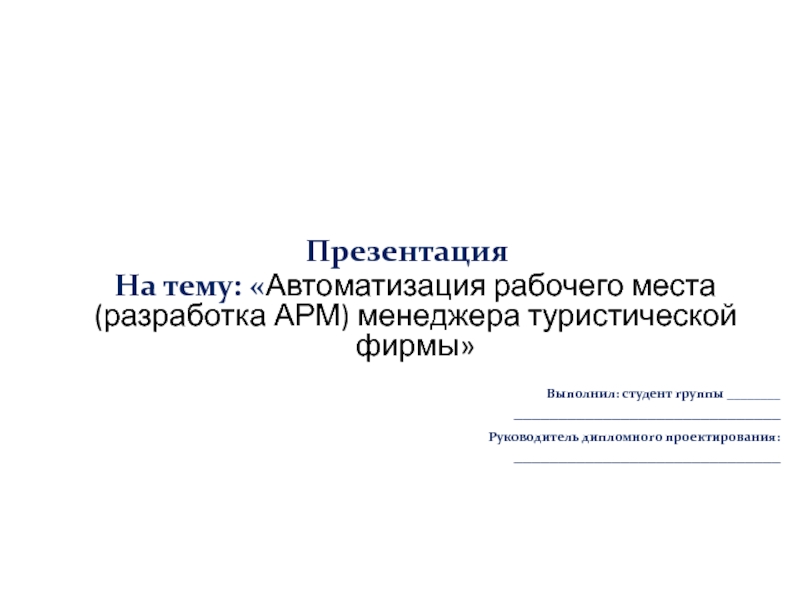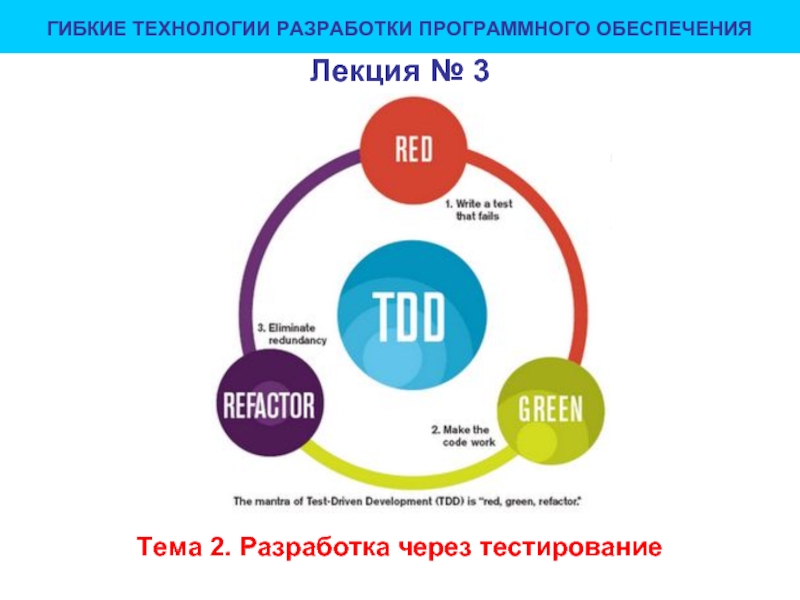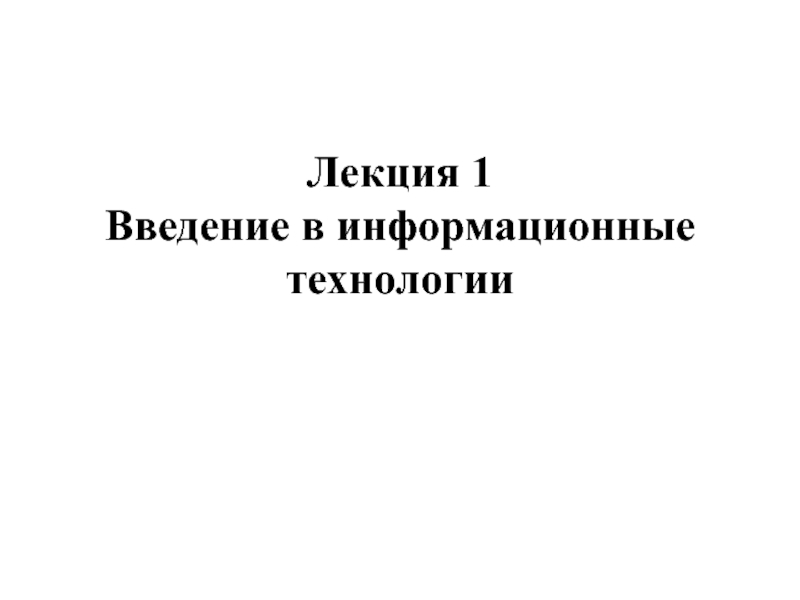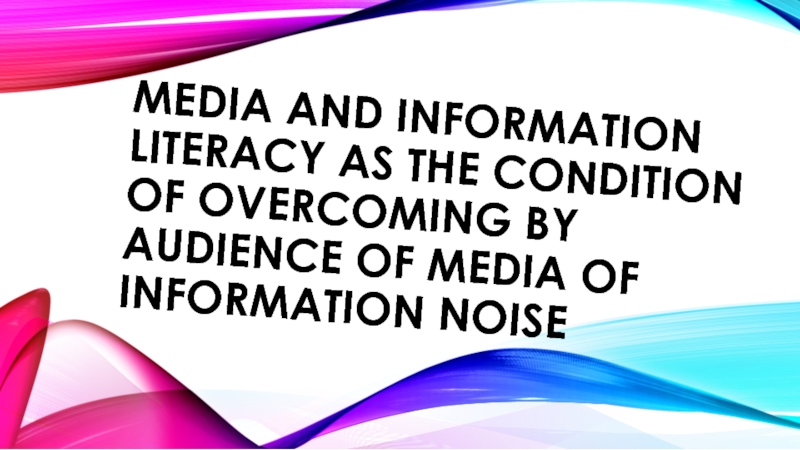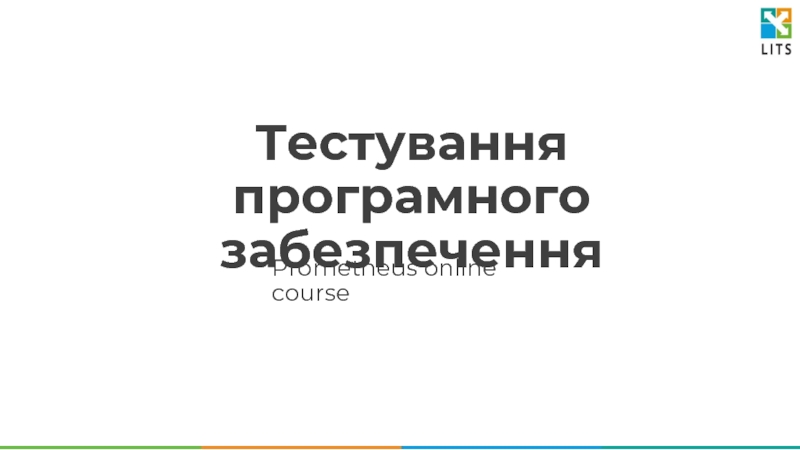- Главная
- Разное
- Дизайн
- Бизнес и предпринимательство
- Аналитика
- Образование
- Развлечения
- Красота и здоровье
- Финансы
- Государство
- Путешествия
- Спорт
- Недвижимость
- Армия
- Графика
- Культурология
- Еда и кулинария
- Лингвистика
- Английский язык
- Астрономия
- Алгебра
- Биология
- География
- Детские презентации
- Информатика
- История
- Литература
- Маркетинг
- Математика
- Медицина
- Менеджмент
- Музыка
- МХК
- Немецкий язык
- ОБЖ
- Обществознание
- Окружающий мир
- Педагогика
- Русский язык
- Технология
- Физика
- Философия
- Химия
- Шаблоны, картинки для презентаций
- Экология
- Экономика
- Юриспруденция
The Inverted Multi-Index презентация
Содержание
- 1. The Inverted Multi-Index
- 2. From images to descriptors
- 3. Query process Dataset of visual descriptors
- 4. Demands Initial setup: Dataset size: few
- 5. Meeting the demands Main observation: the vectors
- 6. The inverted index Sivic & Zisserman ICCV 2003
- 7. Querying the inverted index Have to consider
- 8. Product quantization [Jegou, Douze, Schmid // TPAMI
- 9. The inverted multi-index Our idea: use product
- 10. Querying the inverted multi-index 1 2 3
- 11. Querying the inverted multi-index – Step 1
- 12. Querying the inverted multi-index – Step 2
- 13. Querying the inverted multi-index
- 14. Experimental protocol Dataset: 1 billion of
- 15. Performance comparison Recall on the dataset of
- 16. Performance comparison Recall on the dataset of 1 billion 128D visual descriptors:
- 17. Time complexity For same K index gets a slight advantage because of BLAS instructions
- 18. Memory organization Overhead from multi-index: Averaging over
- 19. Why two? For larger number of parts:
- 20. Multi-Index + Reranking "Multi-ADC": use m bytes
- 21. Multi-ADC vs. Exhaustive search
- 22. Multi-D-ADC vs State-of-the-art
- 23. Performance on 80 million GISTs Multi-D-ADC performance:
- 24. Retrieval examples Exact NN Uncompressed
- 25. Multi-Index and PCA (128->32 dimensions)
- 26. Conclusions A new data structure for indexing
- 27. Other usage scenarios Large-scale NN search' based
- 28. Visual search Van Gogh, 1890 "Landscape with
Слайд 3Query process
Dataset of visual descriptors
Image set:
Query:
Important extras:
+ geometric verification
+ query expansion
Main
Finding similar descriptors
Слайд 4
Demands
Initial setup:
Dataset size: few million images
Typical RAM size: few dozen gigabytes
Tolerable
Search problem:
Dataset size: few billion features
Feature footprint: ~ a dozen bytes
Tolerable time: few milliseconds per feature
Dataset of visual descriptors
Each image has ~1000 descriptors
nearest neighbor search problem we are tackling
Слайд 5Meeting the demands
Main observation: the vectors have a specific structure: correlated
Technologies:
Dimensionality reduction
Vector quantization
Inverted index
Locality-sensitive hashing
Product quantization
Binary/Hamming encodings
Best combinations (previous state-of-the-art):
Inverted index + Product Quantization [Jegou et al. TPAMI 2011]
Inverted index + Binary encoding [Jegou et al. ECCV 2008]
Our contribution:
Inverted Multi-Index
New state-of-the-art for BIGANN:
Inverted multi-index + Product Quantization [CVPR 2012]
Слайд 7Querying the inverted index
Have to consider several words for best accuracy
Want
Want to spend as little time as possible for matching to codebooks
conflict
Query:
Слайд 8Product quantization
[Jegou, Douze, Schmid // TPAMI 2011]:
Split vector into correlated subvectors
use
For a budget of 4 bytes per descriptor:
Can use a single codebook with 1 billion codewords many minutes 128GB
Can use 4 different codebooks with 256 codewords each < 1 millisecond 32KB
IVFADC+ variants (state-of-the-art for billion scale datasets) =
inverted index for indexing + product quantization for reranking
Quantization vs. Product quantization:
Слайд 9The inverted multi-index
Our idea: use product quantization for indexing
Main advantage:
For
Main problem:
Very non-uniform entry size distribution
Слайд 10Querying the inverted multi-index
1
2
3
4
5
6
7
8
9
10
Input: query
Output: stream of entries
Answer to the query:
Слайд 12Querying the inverted multi-index – Step 2
1
2
3
4
5
6
1
2
3
4
5
6
1
2
3
4
5
6
1
2
3
4
5
6
1
2
3
4
5
6
1
2
3
4
5
6
Step 2: the multi-sequence algorithm
Слайд 14Experimental protocol
Dataset:
1 billion of SIFT vectors [Jegou et al.]
Hold-out set
Comparing index and multi-index:
Set a candidate set length T
For each query:
Retrieve closest entries from index or multi-index and concatenate lists
Stop when the next entry does not fit
For small T inverted index can return empty list
Check whether the true neighbor is in the list
Report the share of queries where the neighbor was present (recall@T)
Слайд 15Performance comparison
Recall on the dataset of 1 billion of visual descriptors:
100x
Time
"How fast can we catch the nearest neighbor to the query?"
K = 214
Слайд 19Why two?
For larger number of parts:
Memory overhead becomes larger
Population densities become
In our experiments, 4 parts with small K=128 may be competitive for some datasets and reasonably short candidate lists (e.g. duplicate search). Indexing is blazingly fast in these cases!
Слайд 20Multi-Index + Reranking
"Multi-ADC": use m bytes to encode the original vector
"Multi-D-ADC": use m bytes to encode the remainder between the original vector and the centroid
Same architecture as IVFADC of Jegou et al., but replaces index with multi-index
faster (efficient caching possible for distance computation)
more accurate
Evaluation protocol:
Query the inverted index for T candidates
Reconstruct the original points and rerank according to the distance to the query
Look whether the true nearest neighbor is within top T*
Слайд 22Multi-D-ADC vs State-of-the-art
State-of-the-art [Jegou et al.]
Combining multi-index + reranking:
Слайд 23Performance on 80 million GISTs
Multi-D-ADC performance:
Index vs Multi-index:
Same protocols as before,
Слайд 24Retrieval examples
Exact NN
Uncompressed GIST
Multi-D-ADC
16 bytes
Exact NN
Uncompressed GIST
Multi-D-ADC
16 bytes
Exact NN
Uncompressed GIST
Multi-D-ADC
16 bytes
Exact
Uncompressed GIST
Multi-D-ADC
16 bytes
Слайд 26Conclusions
A new data structure for indexing the visual descriptors
Significant accuracy
Code available (will soon be online)
Слайд 27Other usage scenarios
Large-scale NN search' based approaches:
Holistic high dimensional image
Pose descriptors
Other multimedia
Additive norms and kernels: L1, Hamming, Mahalanobis, chi-square kernel, intersection kernel, etc.
(Mostly) straightforward extensions possible:
Слайд 28Visual search
Van Gogh, 1890
"Landscape with Carriage and Train in the Background"
Pushkin
Collection of many millions of fine art images
What is this painting?
Learn more about it
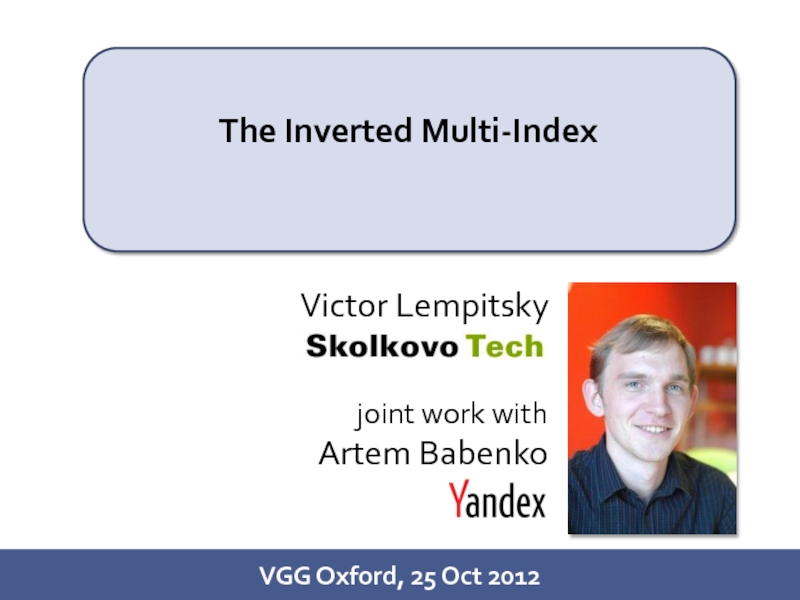
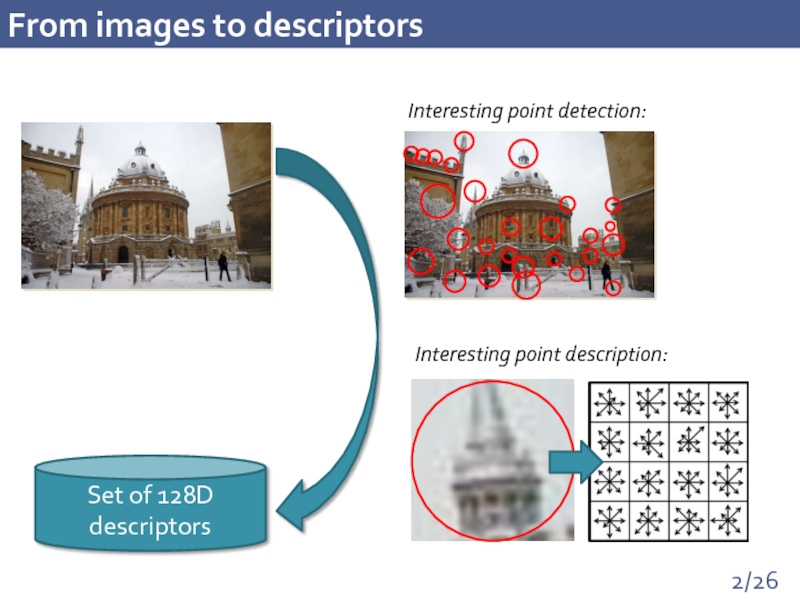
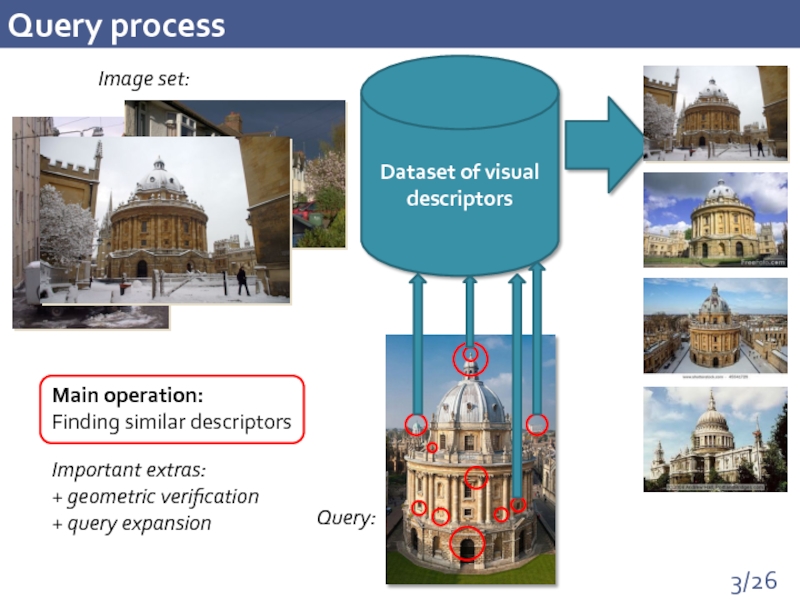
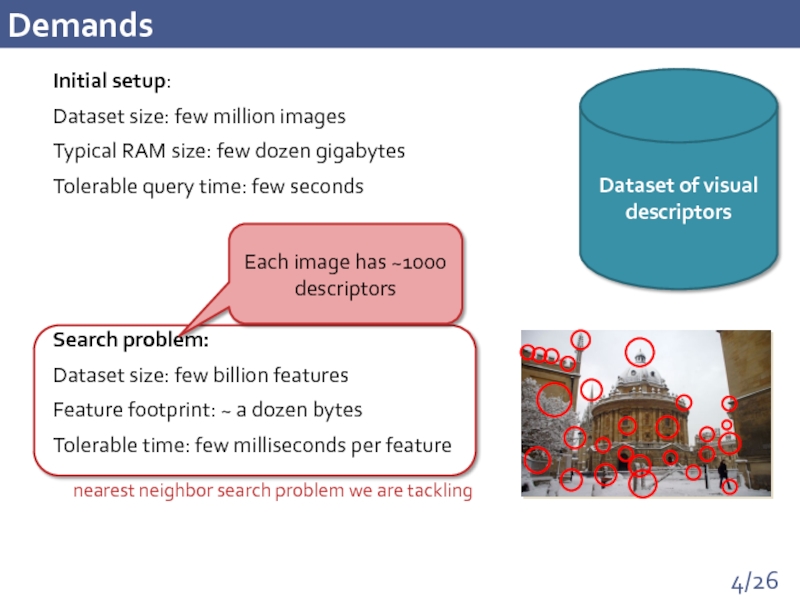
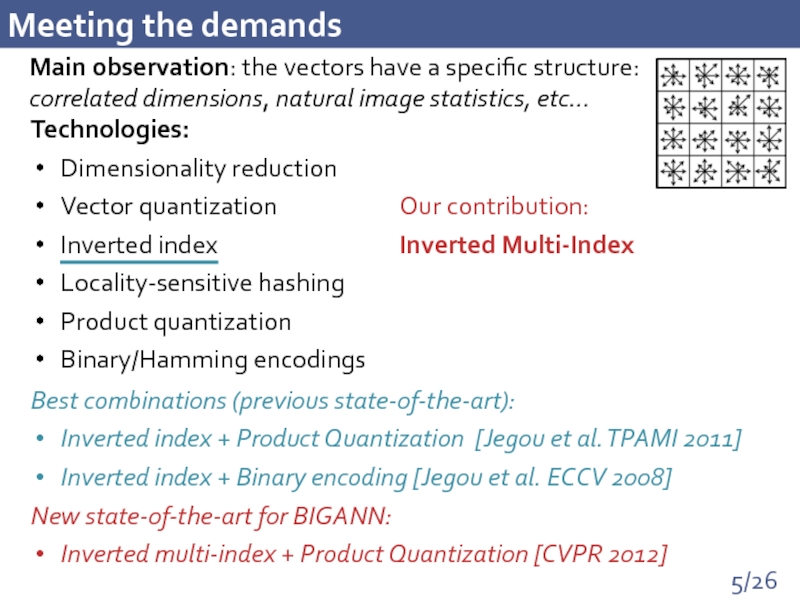
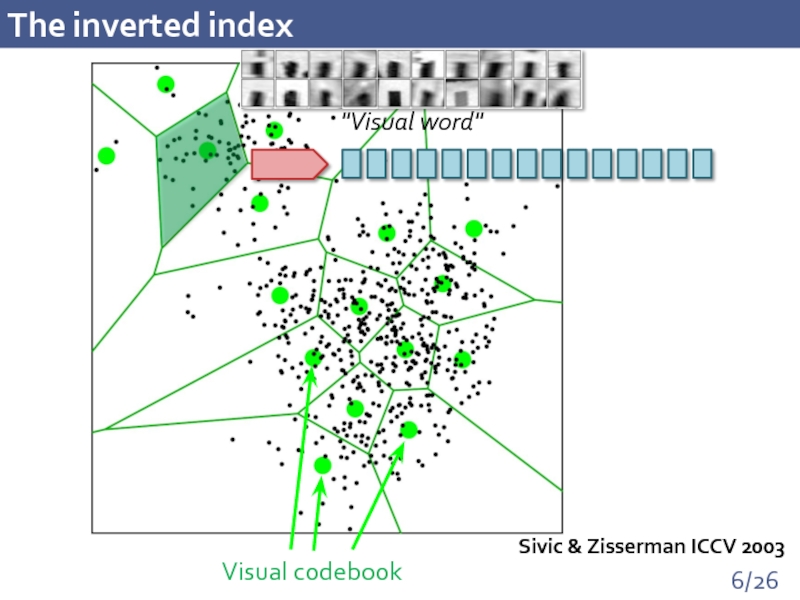
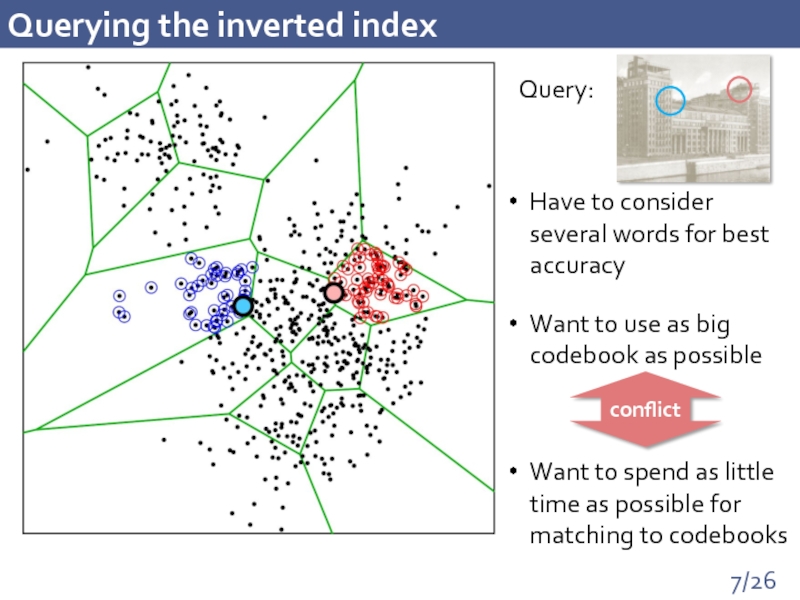
![Product quantization[Jegou, Douze, Schmid // TPAMI 2011]:Split vector into correlated subvectorsuse separate small codebook for](/img/tmb/4/365689/6282f1e8276fb306e2f825637f6190e4-800x.jpg)
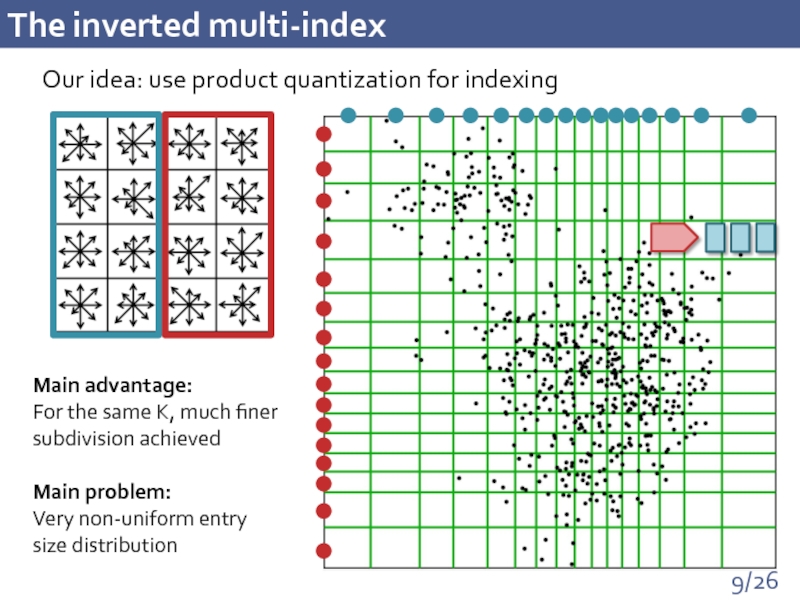
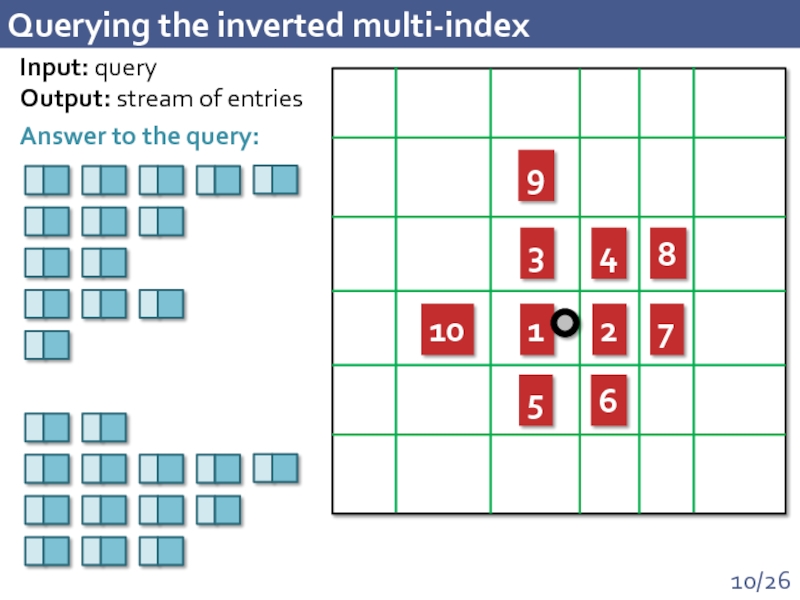
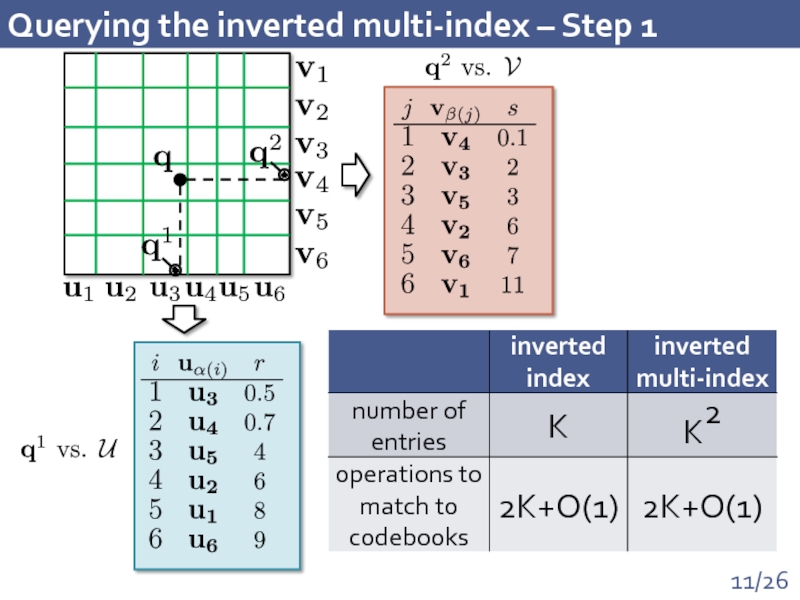
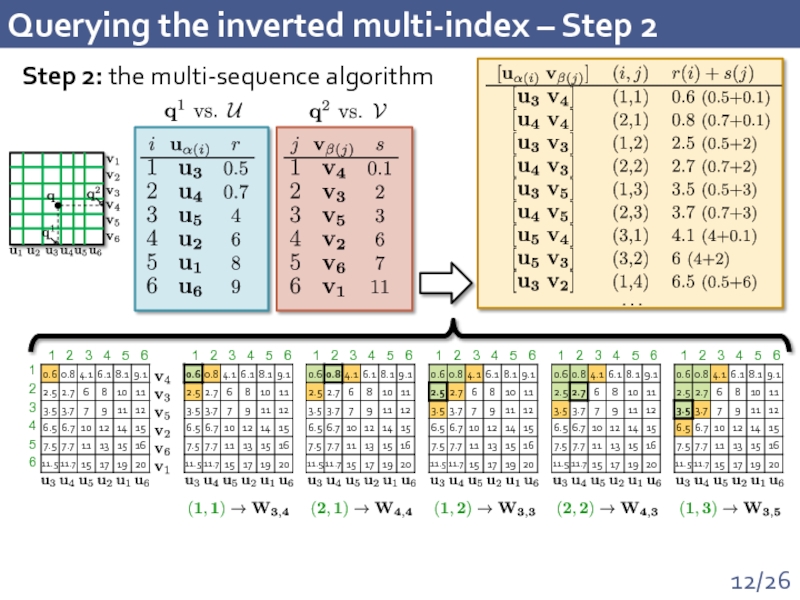
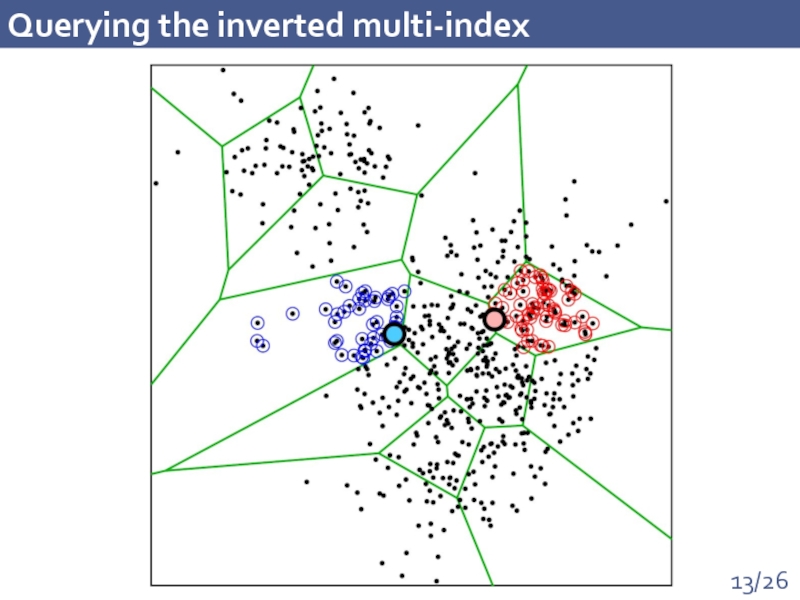
![Experimental protocolDataset: 1 billion of SIFT vectors [Jegou et al.]Hold-out set of 10000 queries, for](/img/tmb/4/365689/6ac7208d83c9094048c3973ee3166de2-800x.jpg)
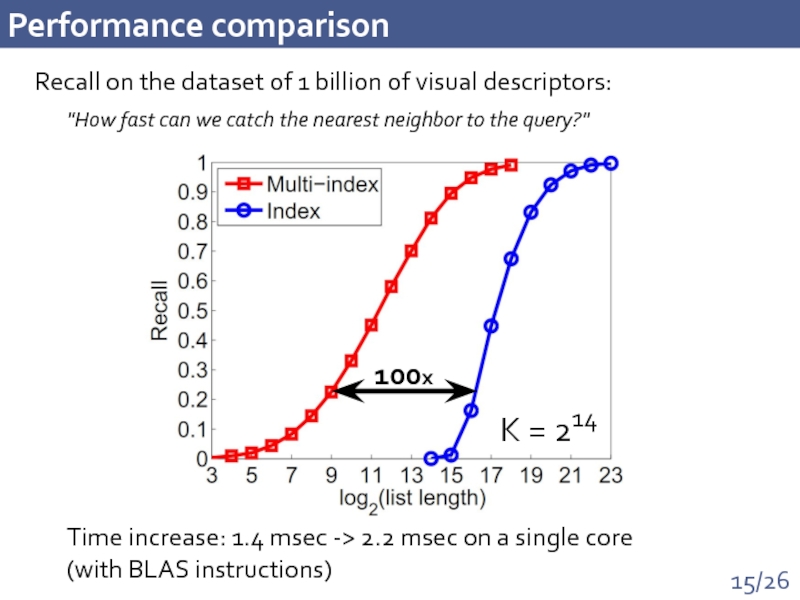
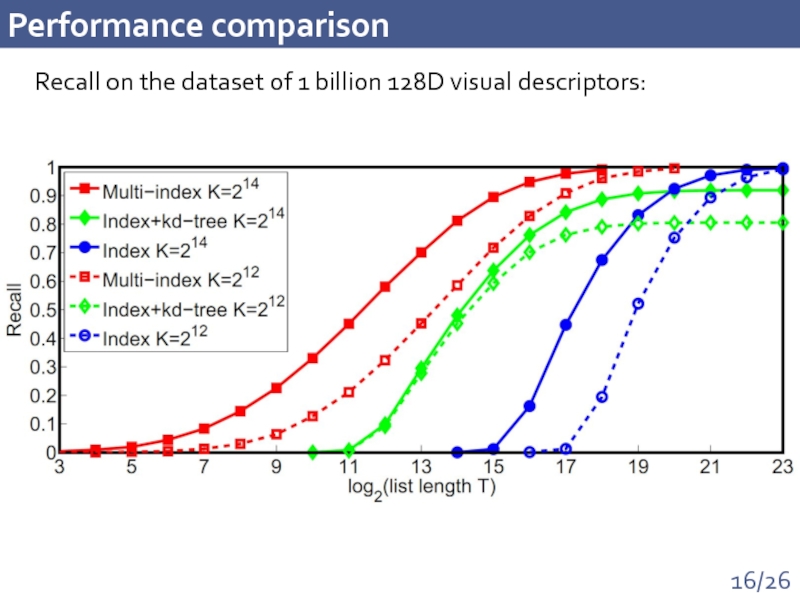
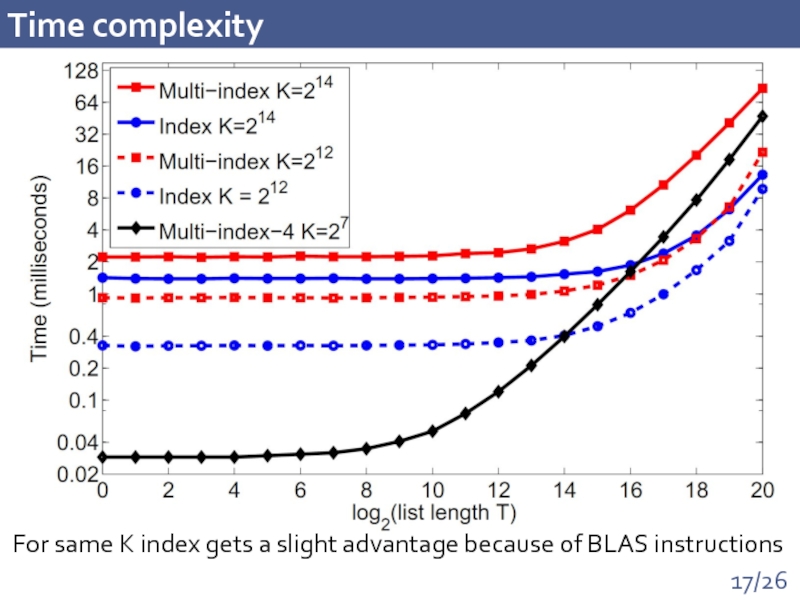
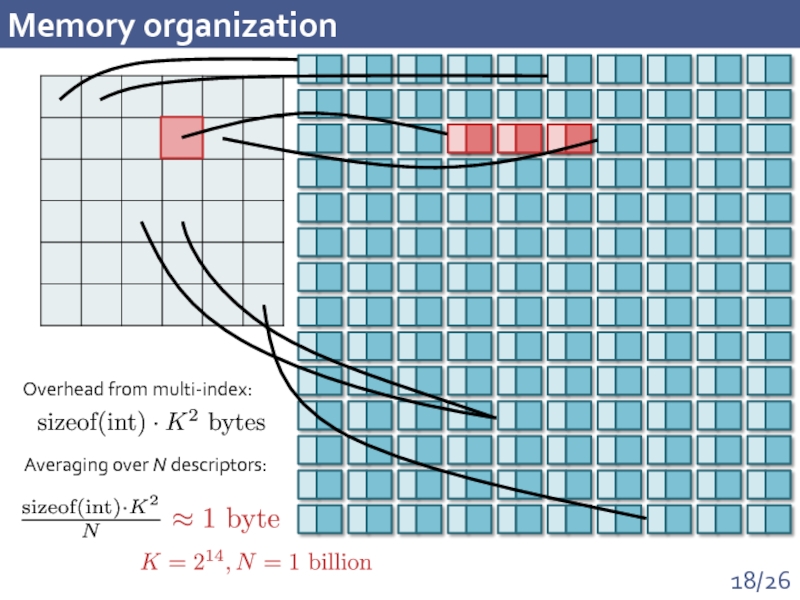
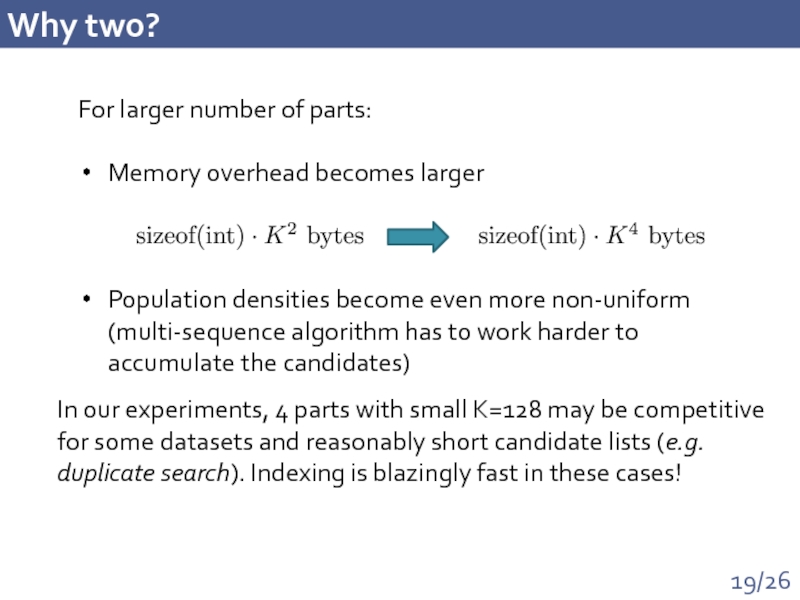
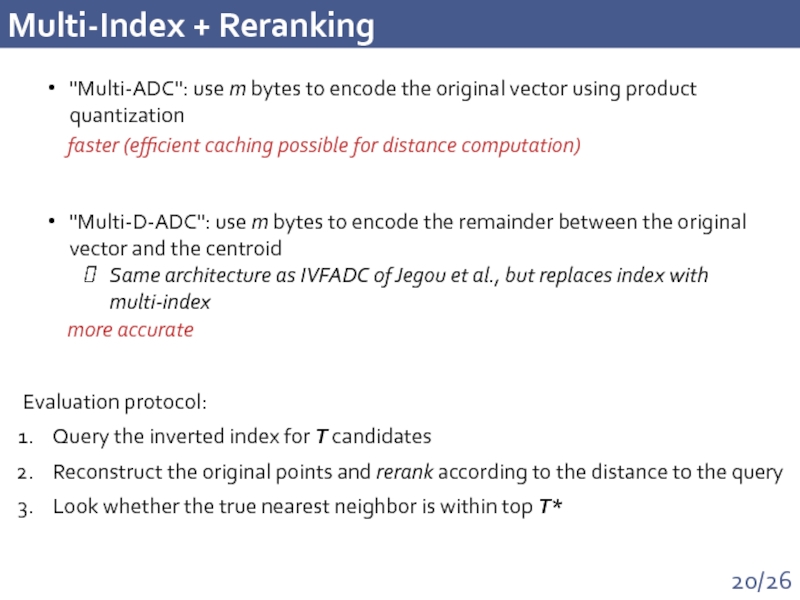
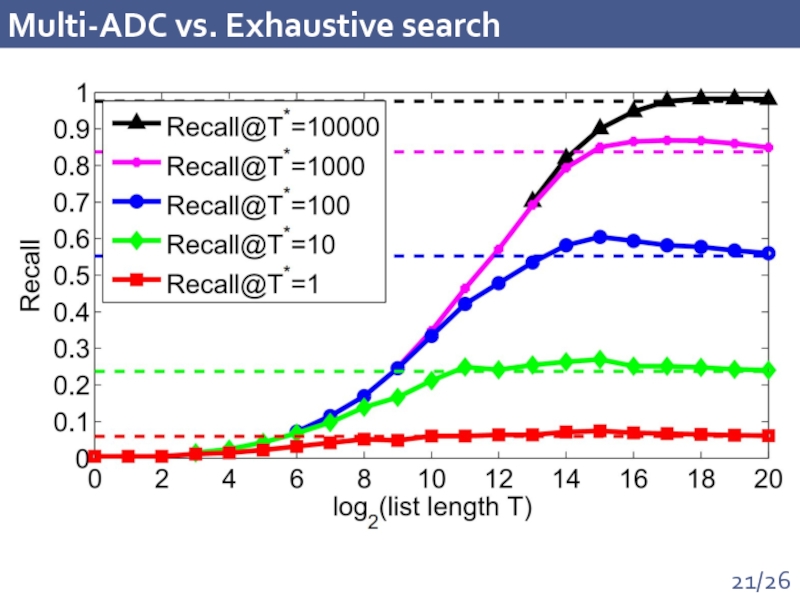
![Multi-D-ADC vs State-of-the-artState-of-the-art [Jegou et al.]Combining multi-index + reranking:](/img/tmb/4/365689/ba0ce46ff15d61d83b4ffa020ce96907-800x.jpg)
